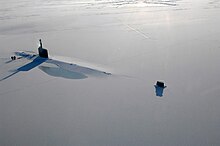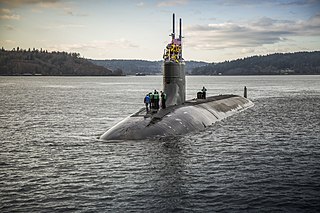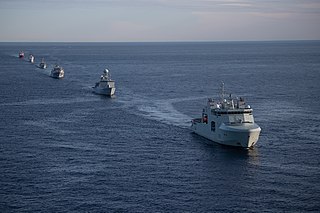
Ice Exercise 2009(ICEX) was a two-week US naval military exercise that took place in March 2009. [1] [2] Its aim was to test submarine operability and war-fighting capability in Arctic conditions. [1] [3]

Ice Exercise 2009(ICEX) was a two-week US naval military exercise that took place in March 2009. [1] [2] Its aim was to test submarine operability and war-fighting capability in Arctic conditions. [1] [3]
Two US Atlantic Fleet Los Angeles-class attack submarines, USS Helena and USS Annapolis, took part in the exercise. [3]
The Russian Pacific Ocean Fleet said it would closely monitor the exercise.[ citation needed ]
Michael Byers of The Globe and Mail speculated that the USS Annapolis might travel to Alaska using a 2,000-kilometre shortcut through the Northwest Passage, which Canada claims as "internal waters". According to maritime law, in Canadian internal waters, Washington must obtain Ottawa's permission for any voyage, whether on the surface or submerged. According to Byers, "Ottawa's failure to protest against the submarine transits could constitute evidence that – in the corridors of international diplomacy, where it really matters – Canada has already surrendered its claim." [3]

The Trafalgar class is a class of nuclear-powered fleet submarines (SSNs) in service with the Royal Navy, and the successor to the Swiftsure class. Like the majority of Royal Navy nuclear submarines, all seven boats were constructed at Barrow-in-Furness shipyard, Cumbria. With only one boat remaining active and in commission and six retired from the seven originally in service, the class makes up part of the Royal Navy's nuclear-powered ‘hunter-killer’ submarine force. The Trafalgar class has nearly been replaced by the larger and more capable Astute class, of which five are commissioned.

USS Skate (SSN-578), the third submarine of the United States Navy named for the skate, a type of ray, was the lead ship of the Skate class of nuclear submarines. She was the third nuclear submarine commissioned, the first to make a completely submerged trans-Atlantic crossing, the second submarine to reach the North Pole, and the first to surface there.

USS Annapolis (SSN-760), is the tenth "improved" Los Angeles-class submarine. Annapolis is the fourth ship of the United States Navy to be named for Annapolis, Maryland, site of the United States Naval Academy.

USS Nautilus (SSN-571) was the world's first operational nuclear-powered submarine and the first submarine to complete a submerged transit of the North Pole on 3 August 1958. Her initial commanding officer was Eugene "Dennis" Wilkinson, a widely respected naval officer who set the stage for many of the protocols of today's Nuclear Navy of the US, and who had a storied career during military service and afterwards.

USS Amberjack (SS-522), a Tench-class submarine, was the second submarine of the United States Navy named for the amberjack, a vigorous sport fish found in the western Atlantic from New England to Brazil.

USS Hartford (SSN-768), a Los Angeles-class submarine, is the second ship of the Navy to be named for Hartford, Connecticut. The contract to build her was awarded to the Electric Boat Division of General Dynamics Corporation in Groton, Connecticut on 30 June 1988 and her keel was laid down on 22 February 1992. She was launched on 4 December 1993 sponsored by Laura O'Keefe, wife of former Secretary of the Navy Sean O'Keefe, and commissioned on 10 December 1994, with Commander George Kasten in command.

HMS Tireless was the third Trafalgar-class nuclear submarine of the Royal Navy. Tireless is the second submarine of the Royal Navy to bear this name. Launched in March 1984, Tireless was sponsored by Sue Squires, wife of Admiral 'Tubby' Squires, and commissioned in October 1985.

HMS Trenchant was a Trafalgar-class nuclear-powered fleet submarine of the Royal Navy built by Vickers Shipbuilding, Barrow-in-Furness. Trenchant was based at HMNB Devonport. She was the third vessel and the second submarine of the Royal Navy to be named for the characteristic of vigour and incisiveness.

USS Connecticut (SSN-22) is a Seawolf-class nuclear powered fast attack submarine operated by the United States Navy. Connecticut is the fifth active United States Ship to be named for the U.S. state of Connecticut, going back to 1776. The contract to build her was awarded to the Electric Boat Division of General Dynamics Corporation in Groton, Connecticut, on 3 May 1991 and her keel was laid down on 14 September 1992. She was launched on 1 September 1997, sponsored by Patricia L. Rowland, wife of the Governor of Connecticut, John G. Rowland, and commissioned on 11 December 1998.

USS Spadefish (SSN-668), a Sturgeon-class submarine, was the second ship of the United States Navy to be named for the spadefish, a spiny-finned fish found in coastal waters of the western Atlantic from Cuba to Cape Cod.

USS Seahorse (SSN-669), a Sturgeon-class attack submarine, was the second submarine and third ship of the United States Navy to be named for the seahorse.

USS Lapon (SSN-661), a Sturgeon-class attack submarine, was the second ship of the United States Navy to be named for the lapon, a scorpionfish of the Pacific coast of North America.

USS Alexandria (SSN-757), is a Los Angeles class nuclear-powered attack submarine and the third vessel of the United States Navy to be named for both Alexandria, Virginia, and Alexandria, Louisiana. The contract to build her was awarded to the Electric Boat Division of General Dynamics Corporation on 26 November 1984. Her keel was laid down in Groton, Connecticut, on 19 June 1987. She was launched on 23 June 1990, sponsored by Mrs. Myrtle "Tookie" Clark, wife of Vice Admiral Glenwood Clark (ret.), and commissioned on 29 June 1991. Alexandria was placed in service on 22 March 1991. A series of sea trials began 16 April and were completed 4 June.

USS Pasadena (SSN-752) is a Los Angeles-class submarine and the third ship of the United States Navy to be named for Pasadena, California.

USS Corporal (SS-346), a Balao-class submarine, was a ship of the United States Navy named for the corporal, an alternate name for the fallfish, found in streams of the eastern United States.

The Rubis class is a series of nuclear-powered attack submarines operated by the French Navy. The class comprises six vessels, the first entering service in 1983 and the last in 1993, with another two being cancelled. All six submarines of the Rubis class are based at Toulon and are part of the Escadrille de sous-marins nucléaires d'attaque. Smaller than contemporary designs of other major world navies, the Rubis class shares many of its system designs with the conventionally-powered Agosta class. In the late 1980s, the Rubis class was proposed as an export to Canada in their plan to acquire nuclear-powered submarines.

Operation Nanook is an annual sovereignty operation and manoeuvre warfare exercise conducted by the Canadian Armed Forces in the Arctic. Sovereignty patrols in the Canadian Arctic Archipelago and northern Canada are conducted by the Canadian Rangers, Canadian Coast Guard in tandem with the Royal Canadian Mounted Police. The exercise portion is intended to train the different elements of the Canadian Armed Forces to operate in the Arctic environment.
The Canada-class submarine was a proposed class of ten nuclear-powered attack submarines to be built for Canadian Forces Maritime Command with an option for two more. Announced in 1987, the class was intended to provide Maritime Command with a method for monitoring Canada's Arctic Ocean area while establishing Canadian sovereignty in the area. The announcement suffered significant public and private criticism and the project was cancelled before any of the submarines could be built.

Ice Exercise was a United States Navy mission in the Arctic Ocean.